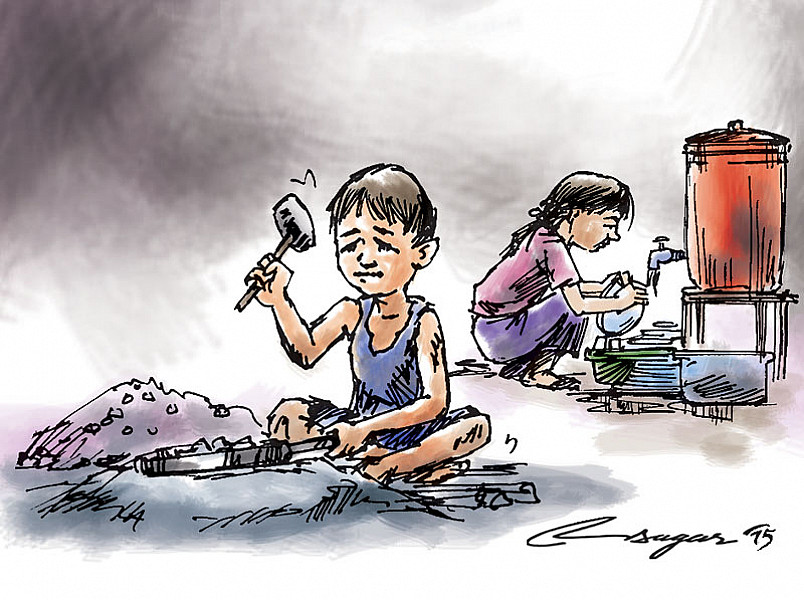As reported by UNICEF, approximately 160 million children worldwide were subject to the child labour in year 2020, 79 million of them are performing hazardous work and 9 million additional children at risk due to the impact of COVID-19. By definition, child labour is violation of child rights, it deprives children of their childhood and is harmful to their mental and physical development. It restricts their fundamental rights and threatens their futures.
Poverty is the primary reason children are sent to work. Although not confined to, the harmful practice of child labour is mainly concentrated in countries with a poor socio-economic background. The largest proportion of child labourers aged 5 to 17 years are in Sub-Saharan Africa with 86.5 million, followed by Central and Southern Asia with 26.3 million. Notably, there is a stark contrast to Latin America and the Carribean, where 8.2 million children are subject to child labour. As International Labour Organization (ILO) reports, most children in child labour work within their own family unit. The agricultural sector accounts for the largest share of child labour worldwide. 70% of all children in child labour, 112 million children in total, work in agriculture.
What are the worst forms of child labour? ILO Convention No. 182 concerning the prohibition and immediate action for the elimination of the worst forms of child labour, defines the worst forms of child labour as all forms of slavery or practices similar to slavery, such as the sale and trafficking of children, debt bondage and serfdom and forced or compulsory labour, including forced or compulsory recruitment of children for use in armed conflict; the use, procuring or offering of a child for prostitution, for the production of pornography or for pornographic performances; the use, procuring or offering of a child for illicit activities, in particular for the production and trafficking of drugs as defined in the relevant international treaties; work which, by its nature or the circumstances in which it is carried out, is likely to harm the health, safety or morals of children (hazardous child labour). To be more specific, hazardous child labour is defined as a work involving dangerous and risky conditions that could lead to child’s death or injury. It may lead to permanent disability, ill health or psychological damage.
As specified by ILO, “Hazardous child labour is the largest category of the worst forms of child labour with an estimated 79 million children, aged 5-17”, working in dangerous conditions in a wide range of sectors, including agriculture, mining, construction, manufacturing, as well as in hotels, bars, restaurants, markets, and domestic service. It is found in both industrialized and developing countries. Girls and boys often start carrying out hazardous work at very early ages. When it comes to gender disparities, boys are more likely to be engaged in child labour. Among all boys, 11.2 per cent are in child labour compared to 7.8 per cent of all girls. Notably, girls are more likely to be involved in unpaid household services.
Child labour is keeping millions of children out of school. Nearly 28% of children aged 5 to 11 years and 35% of children aged 12 to 14 years in child labour are out of school. The rates are alarming, given the largest share of out of school children are very young, within the age range for compulsory education. Even for those children in child labor who attend school, it is very difficult for them to balance the demands of education and their work. This severely constrains their prospects for future life opportunities and their potential overall.
Recent years have seen significant progress in the fight against child labour. However, the rise of child labour throughout the COVID-19 pandemic was predictable. Economic hardships caused by the pandemic took a toll on millions of families around the world. In times of crisis, child labour becomes a coping mechanism for many families, as expectations that children contribute financially can intensify. Roughly 9 million additional children are at risk being pushed into the child labour. Most governments around the world have temporarily closed educational institutions to reduce the spread of COVID-19. Many schools moved to distance learning, but nearly half of the world has no access to internet. Even after classes restarted, many families are no longer able to send their children to schools.
Also, due to school closing, children who are already engaged in child labour may be working longer hours or in worse conditions, and many more children may be forced to engage in the worst forms of child labour as a result of job and income losses among vulnerable families. When children leave school and enter paid employment, it is usually very difficult to resume their education.
According to UNICEF Executive Director Henrietta Fore, “As poverty rises, schools close and the availability of social services decreases, more children are pushed into the workforce. As we reimagine the world post-COVID, we need to make sure that children and their families have the tools they need to weather similar storms in the future. Quality education, social protection services and better economic opportunities can be game changers.”
The international community has put forward several important agreements on child rights. one of the most important of them being: ILO Convention No. 182 concerning the prohibition and immediate action for the elimination of the worst forms of child labour. Remarkably, Convention No 182 is the fastest ratified agreements in the ILO’s and UN’s history. The purpose of the convention is to effectively eradicate the worst forms of child labour, taking into account the importance of free basic education and the need to remove the children involved and to provide for their rehabilitation and social integration. Relevant government institutions and international organizations for decades have been joining recourses to eliminate child labour. As a result, in 2020, child labour has decreased by 38% in the last decade. However, the Pandemic has significantly affected the progress towards ending child labour. Still, a joint initiative in line with global commitments and goals can reverse the stagnation. Despite the hindrance caused by the pandemic, the world aims to eliminate the harmful practice of child labour by the year 2025.
Illustration: Ratna Sagar Shrestha/THT

